Opher Lieber
Jamba-1.5: Hybrid Transformer-Mamba Models at Scale
Aug 22, 2024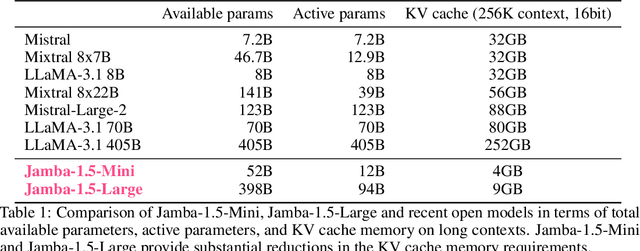
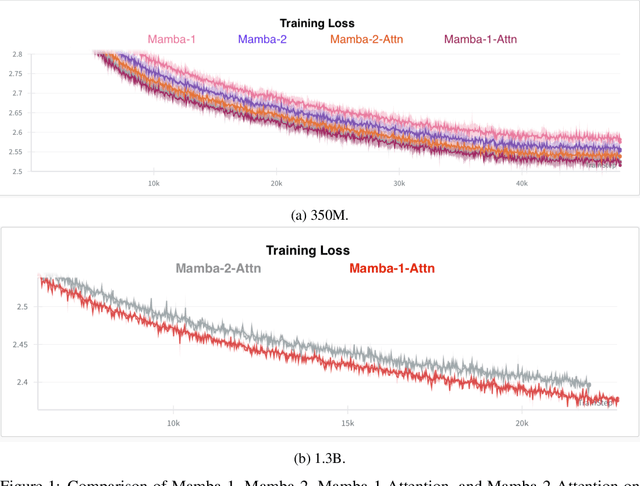
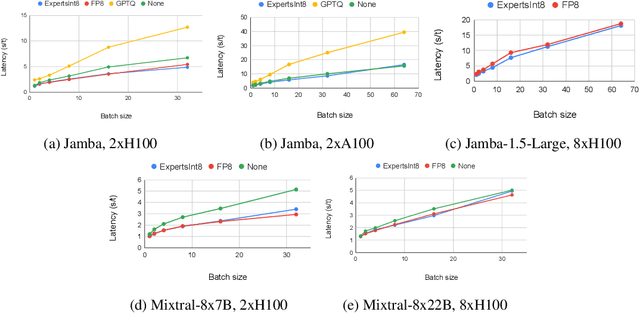
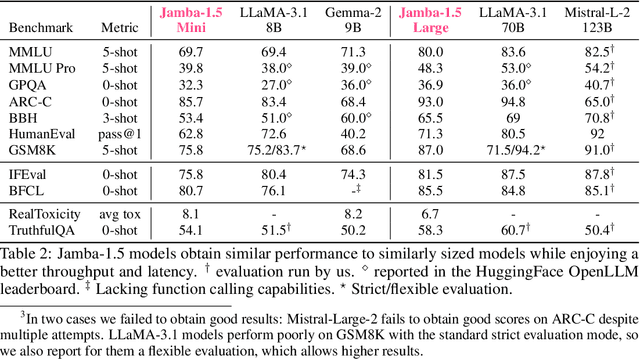
Abstract:We present Jamba-1.5, new instruction-tuned large language models based on our Jamba architecture. Jamba is a hybrid Transformer-Mamba mixture of experts architecture, providing high throughput and low memory usage across context lengths, while retaining the same or better quality as Transformer models. We release two model sizes: Jamba-1.5-Large, with 94B active parameters, and Jamba-1.5-Mini, with 12B active parameters. Both models are fine-tuned for a variety of conversational and instruction-following capabilties, and have an effective context length of 256K tokens, the largest amongst open-weight models. To support cost-effective inference, we introduce ExpertsInt8, a novel quantization technique that allows fitting Jamba-1.5-Large on a machine with 8 80GB GPUs when processing 256K-token contexts without loss of quality. When evaluated on a battery of academic and chatbot benchmarks, Jamba-1.5 models achieve excellent results while providing high throughput and outperforming other open-weight models on long-context benchmarks. The model weights for both sizes are publicly available under the Jamba Open Model License and we release ExpertsInt8 as open source.
Jamba: A Hybrid Transformer-Mamba Language Model
Mar 28, 2024



Abstract:We present Jamba, a new base large language model based on a novel hybrid Transformer-Mamba mixture-of-experts (MoE) architecture. Specifically, Jamba interleaves blocks of Transformer and Mamba layers, enjoying the benefits of both model families. MoE is added in some of these layers to increase model capacity while keeping active parameter usage manageable. This flexible architecture allows resource- and objective-specific configurations. In the particular configuration we have implemented, we end up with a powerful model that fits in a single 80GB GPU. Built at large scale, Jamba provides high throughput and small memory footprint compared to vanilla Transformers, and at the same time state-of-the-art performance on standard language model benchmarks and long-context evaluations. Remarkably, the model presents strong results for up to 256K tokens context length. We study various architectural decisions, such as how to combine Transformer and Mamba layers, and how to mix experts, and show that some of them are crucial in large scale modeling. We also describe several interesting properties of these architectures which the training and evaluation of Jamba have revealed, and plan to release checkpoints from various ablation runs, to encourage further exploration of this novel architecture. We make the weights of our implementation of Jamba publicly available under a permissive license.
MRKL Systems: A modular, neuro-symbolic architecture that combines large language models, external knowledge sources and discrete reasoning
May 01, 2022
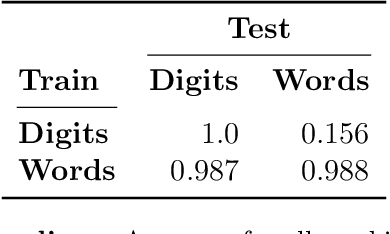


Abstract:Huge language models (LMs) have ushered in a new era for AI, serving as a gateway to natural-language-based knowledge tasks. Although an essential element of modern AI, LMs are also inherently limited in a number of ways. We discuss these limitations and how they can be avoided by adopting a systems approach. Conceptualizing the challenge as one that involves knowledge and reasoning in addition to linguistic processing, we define a flexible architecture with multiple neural models, complemented by discrete knowledge and reasoning modules. We describe this neuro-symbolic architecture, dubbed the Modular Reasoning, Knowledge and Language (MRKL, pronounced "miracle") system, some of the technical challenges in implementing it, and Jurassic-X, AI21 Labs' MRKL system implementation.
Standing on the Shoulders of Giant Frozen Language Models
Apr 21, 2022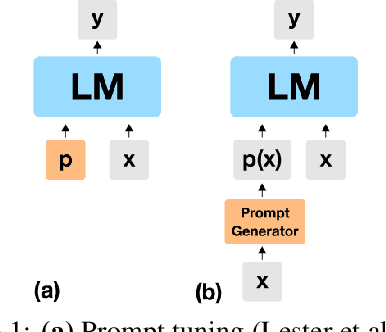
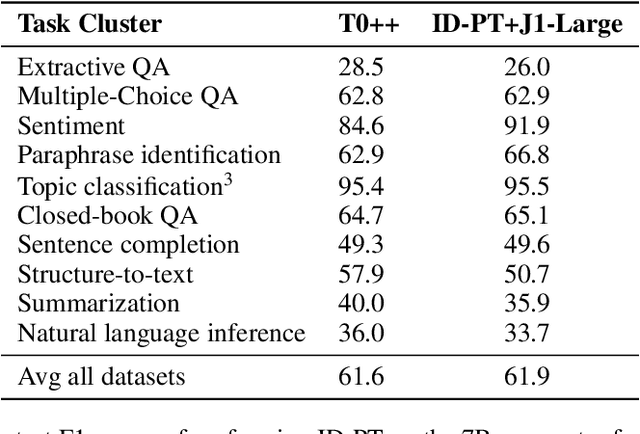
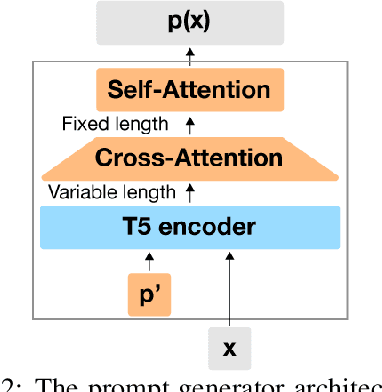

Abstract:Huge pretrained language models (LMs) have demonstrated surprisingly good zero-shot capabilities on a wide variety of tasks. This gives rise to the appealing vision of a single, versatile model with a wide range of functionalities across disparate applications. However, current leading techniques for leveraging a "frozen" LM -- i.e., leaving its weights untouched -- still often underperform fine-tuning approaches which modify these weights in a task-dependent way. Those, in turn, suffer forgetfulness and compromise versatility, suggesting a tradeoff between performance and versatility. The main message of this paper is that current frozen-model techniques such as prompt tuning are only the tip of the iceberg, and more powerful methods for leveraging frozen LMs can do just as well as fine tuning in challenging domains without sacrificing the underlying model's versatility. To demonstrate this, we introduce three novel methods for leveraging frozen models: input-dependent prompt tuning, frozen readers, and recursive LMs, each of which vastly improves on current frozen-model approaches. Indeed, some of our methods even outperform fine-tuning approaches in domains currently dominated by the latter. The computational cost of each method is higher than that of existing frozen model methods, but still negligible relative to a single pass through a huge frozen LM. Each of these methods constitutes a meaningful contribution in its own right, but by presenting these contributions together we aim to convince the reader of a broader message that goes beyond the details of any given method: that frozen models have untapped potential and that fine-tuning is often unnecessary.
PMI-Masking: Principled masking of correlated spans
Oct 05, 2020



Abstract:Masking tokens uniformly at random constitutes a common flaw in the pretraining of Masked Language Models (MLMs) such as BERT. We show that such uniform masking allows an MLM to minimize its training objective by latching onto shallow local signals, leading to pretraining inefficiency and suboptimal downstream performance. To address this flaw, we propose PMI-Masking, a principled masking strategy based on the concept of Pointwise Mutual Information (PMI), which jointly masks a token n-gram if it exhibits high collocation over the corpus. PMI-Masking motivates, unifies, and improves upon prior more heuristic approaches that attempt to address the drawback of random uniform token masking, such as whole-word masking, entity/phrase masking, and random-span masking. Specifically, we show experimentally that PMI-Masking reaches the performance of prior masking approaches in half the training time, and consistently improves performance at the end of training.
 Add to Chrome
Add to Chrome Add to Firefox
Add to Firefox Add to Edge
Add to Edge